
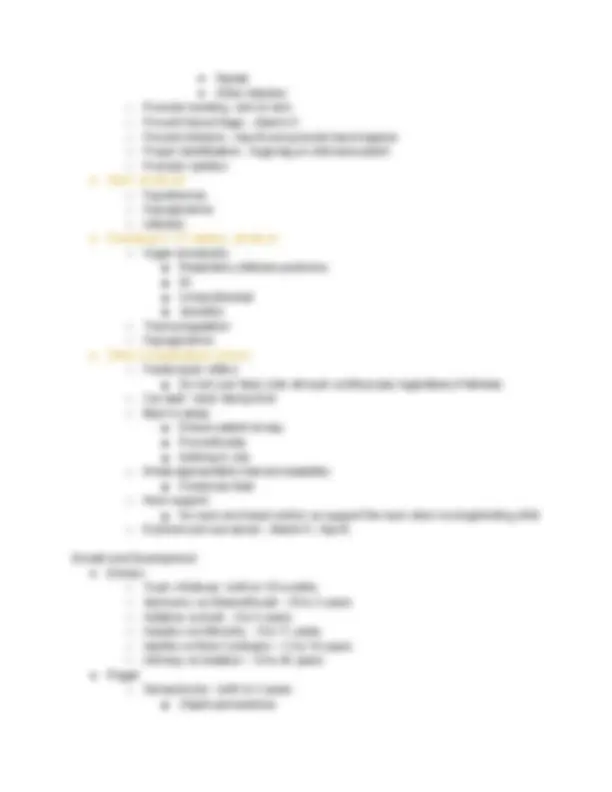
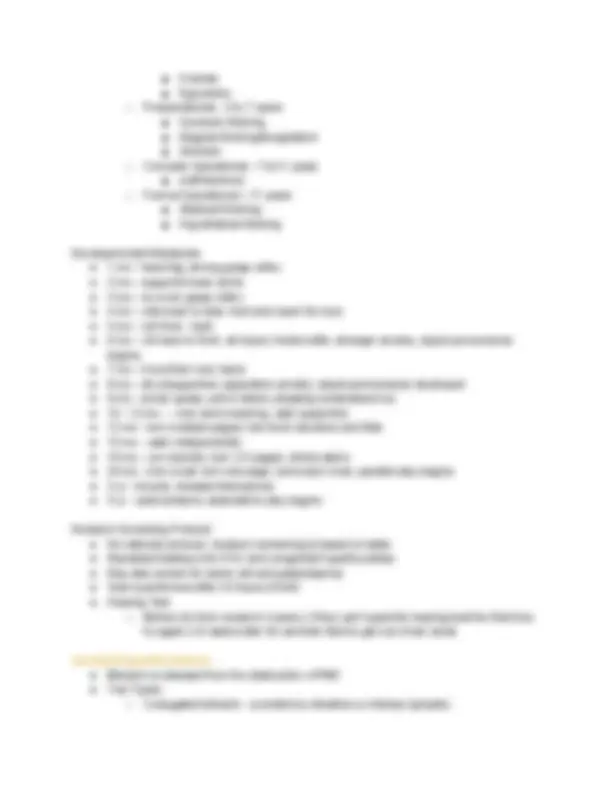
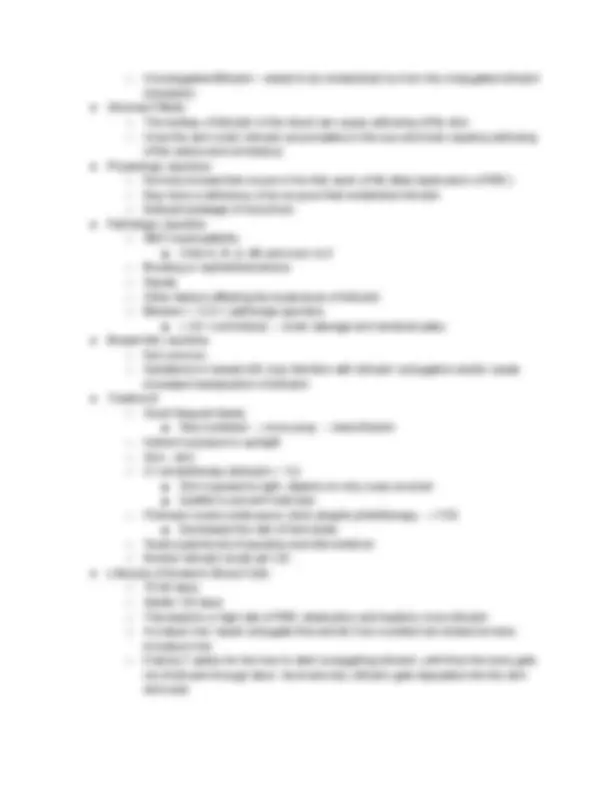
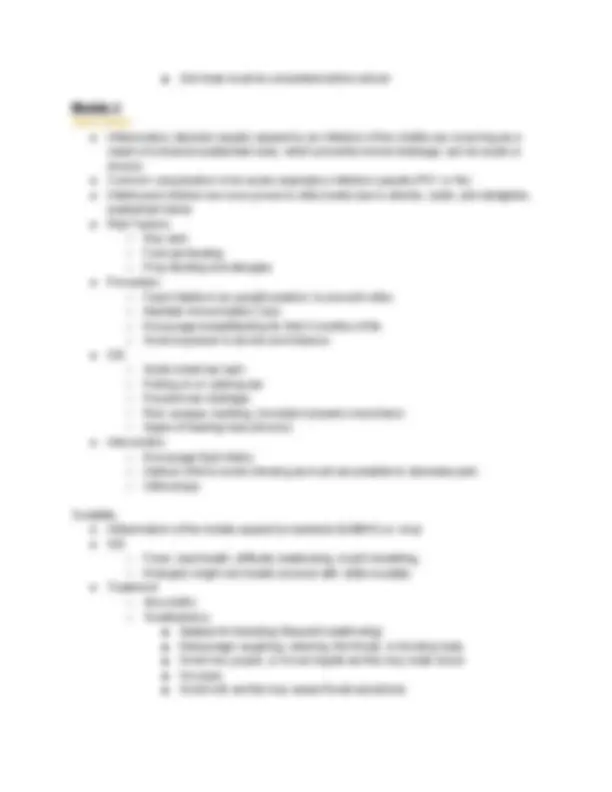
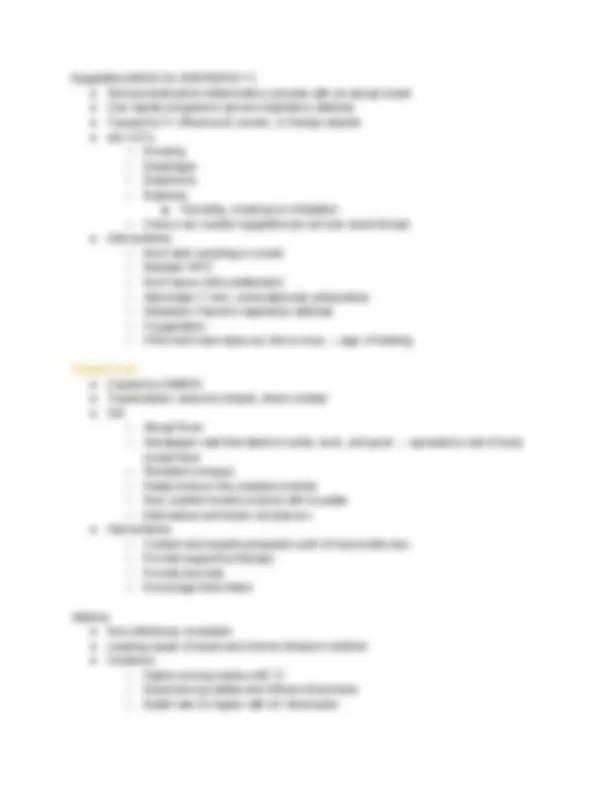
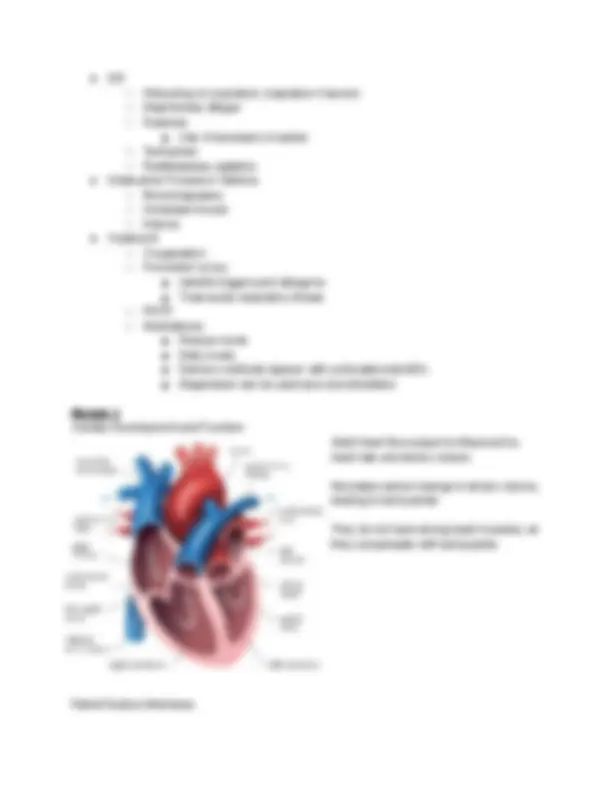
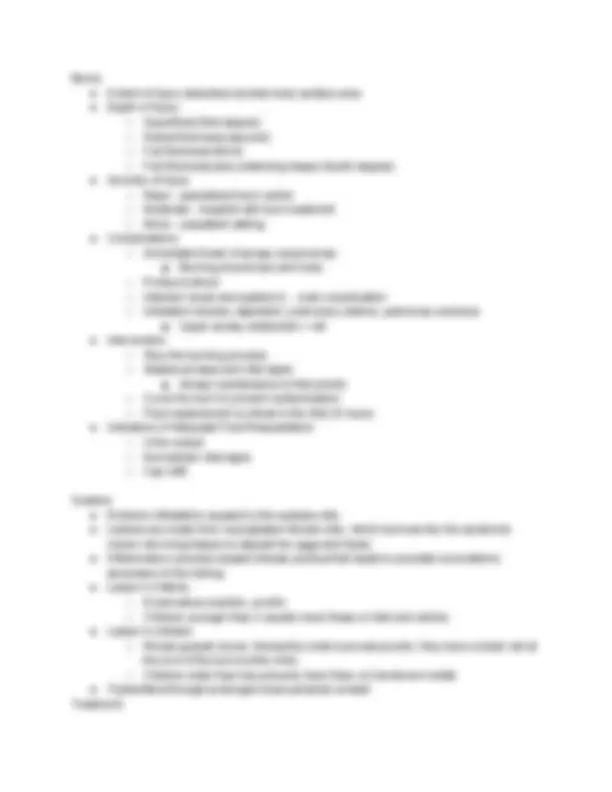
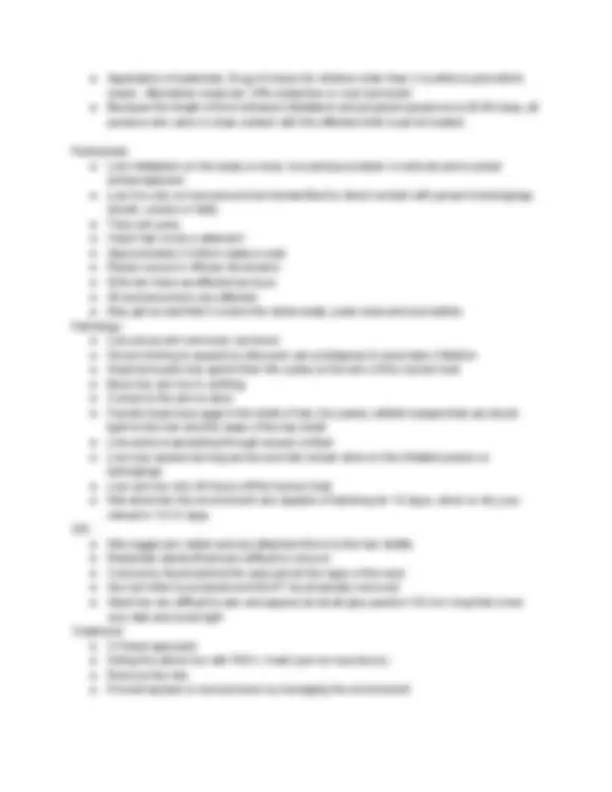
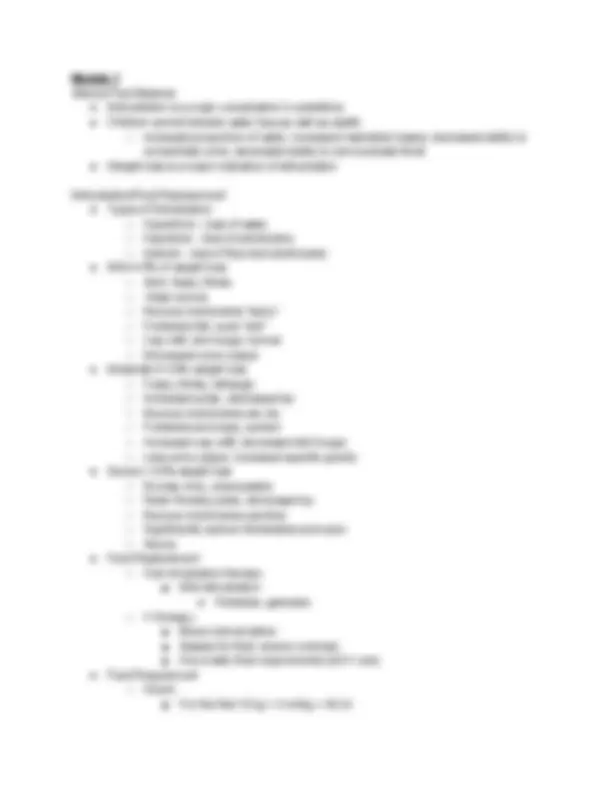
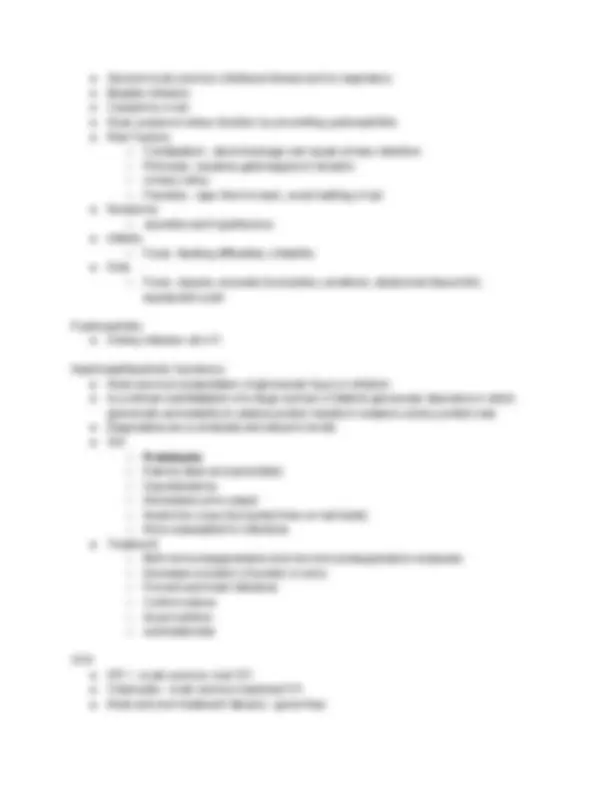
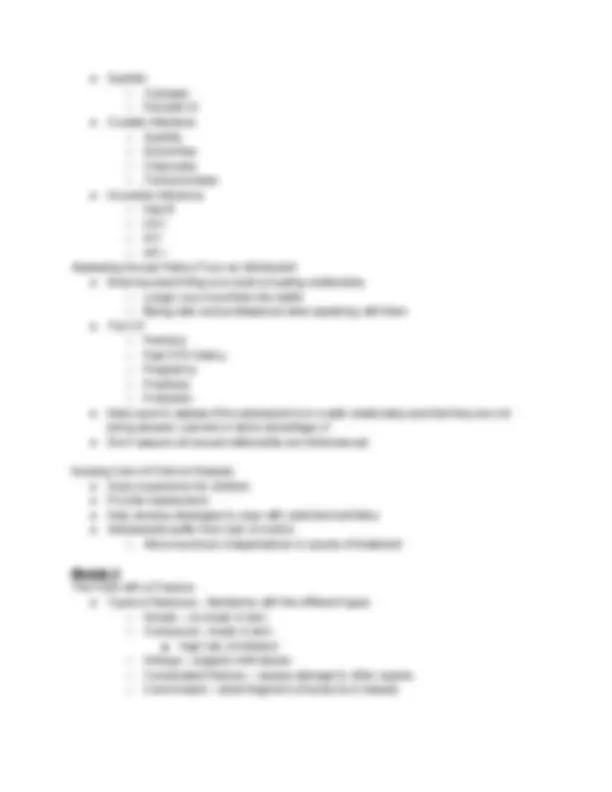
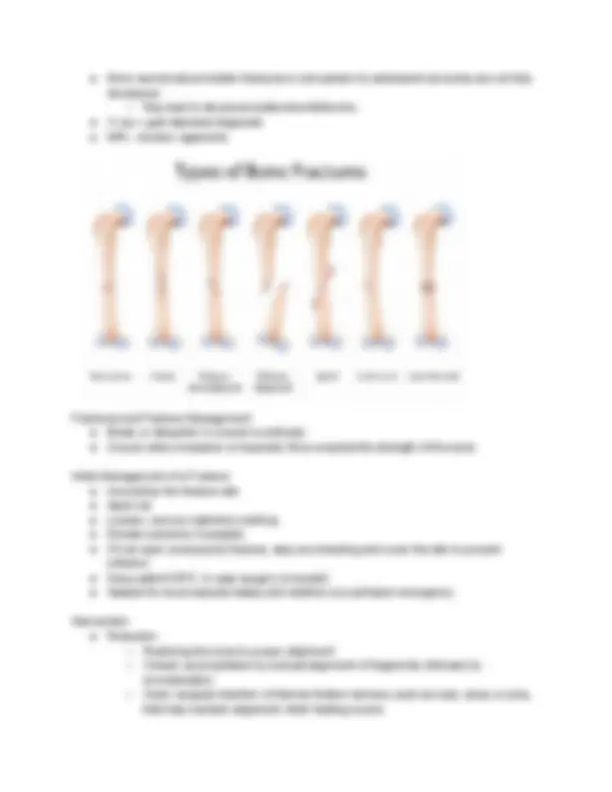
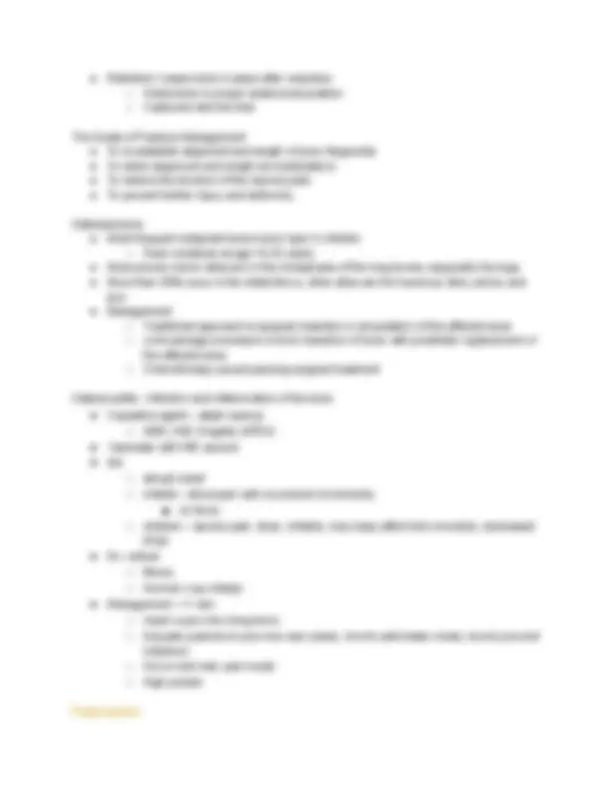
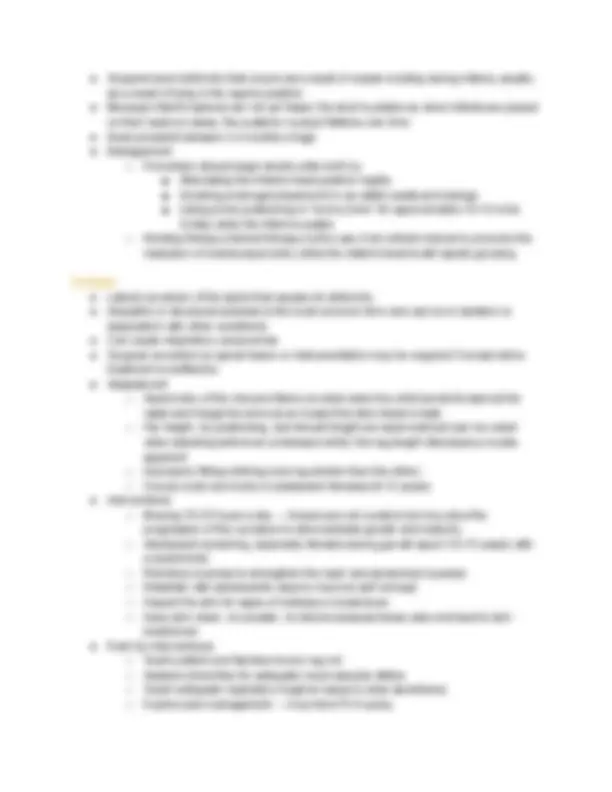
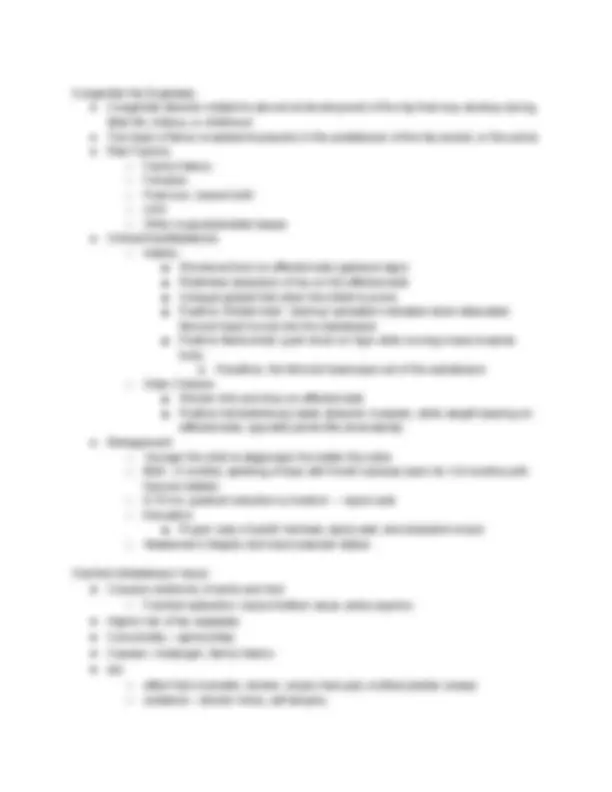
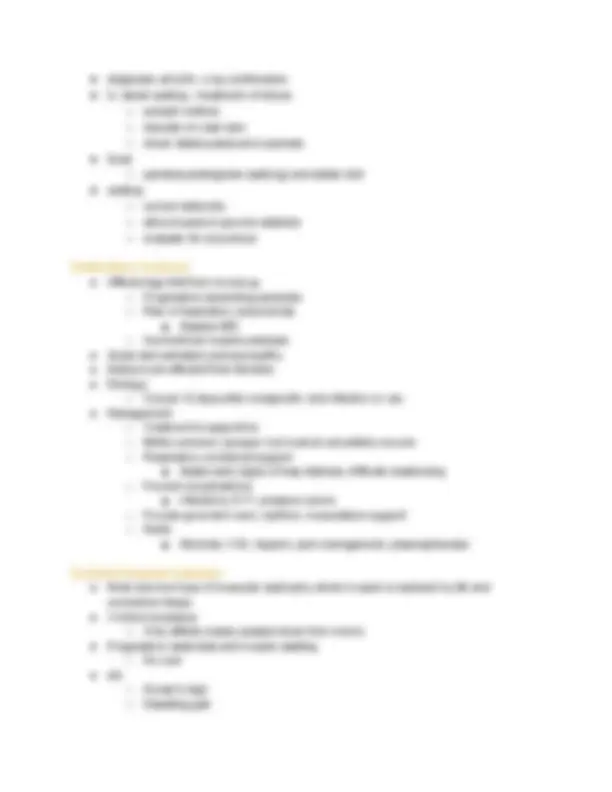
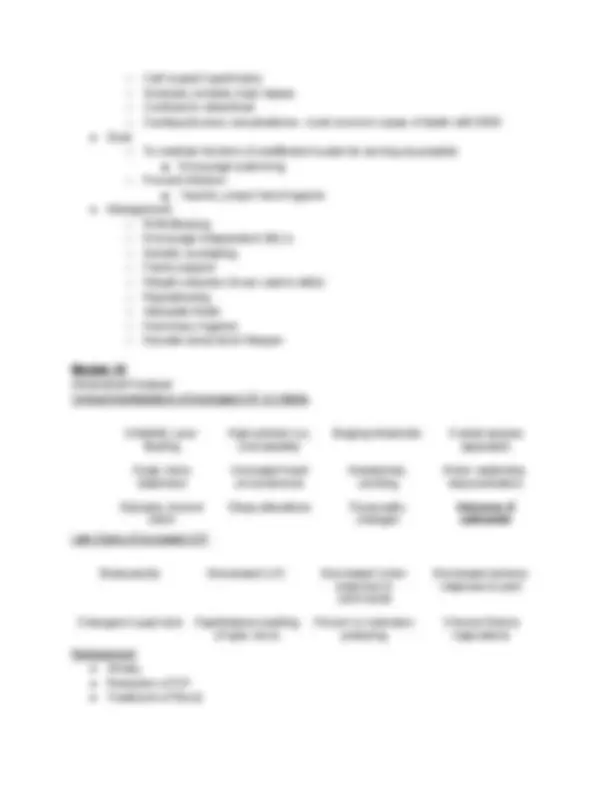
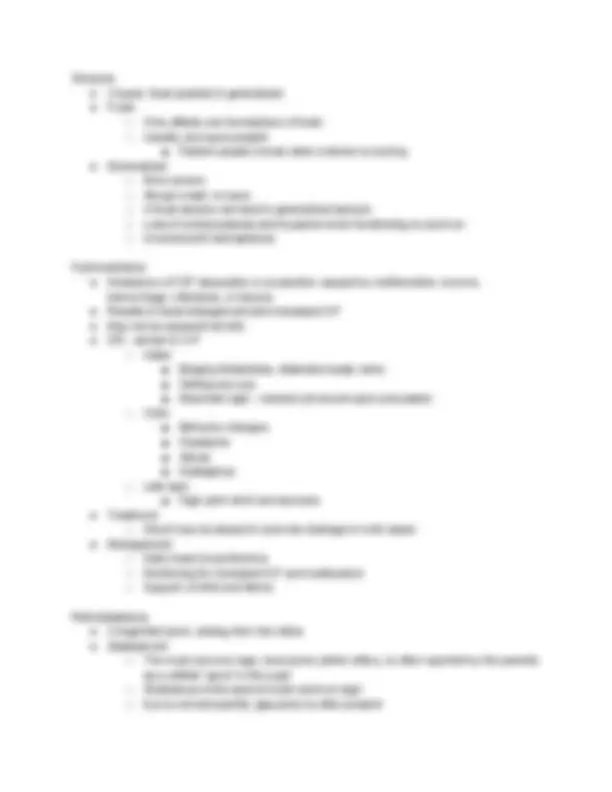
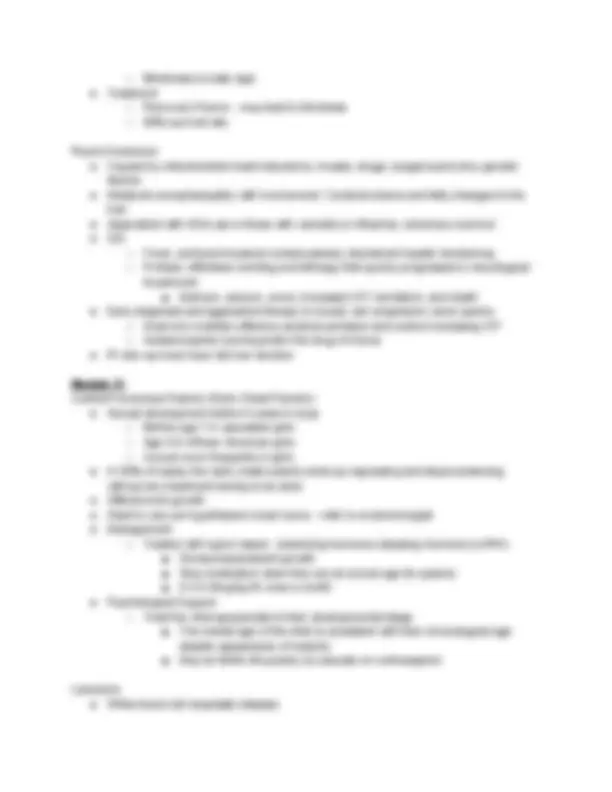
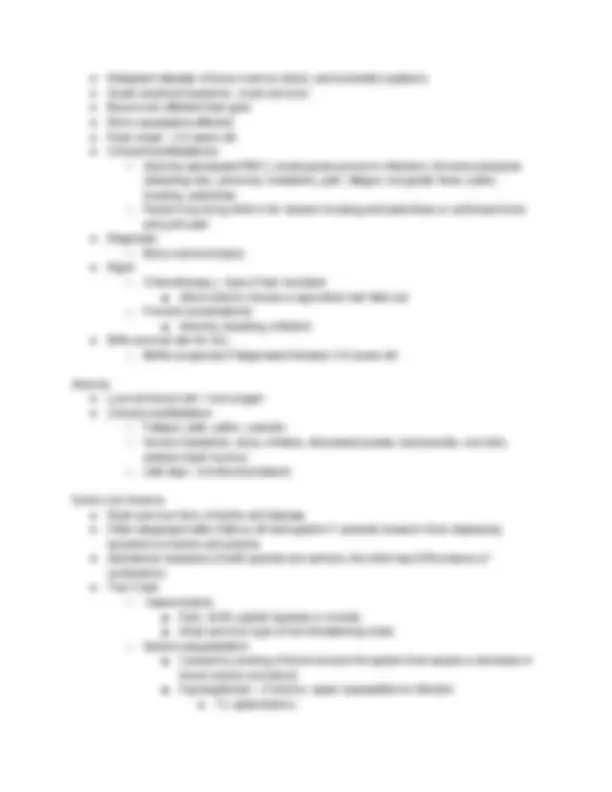
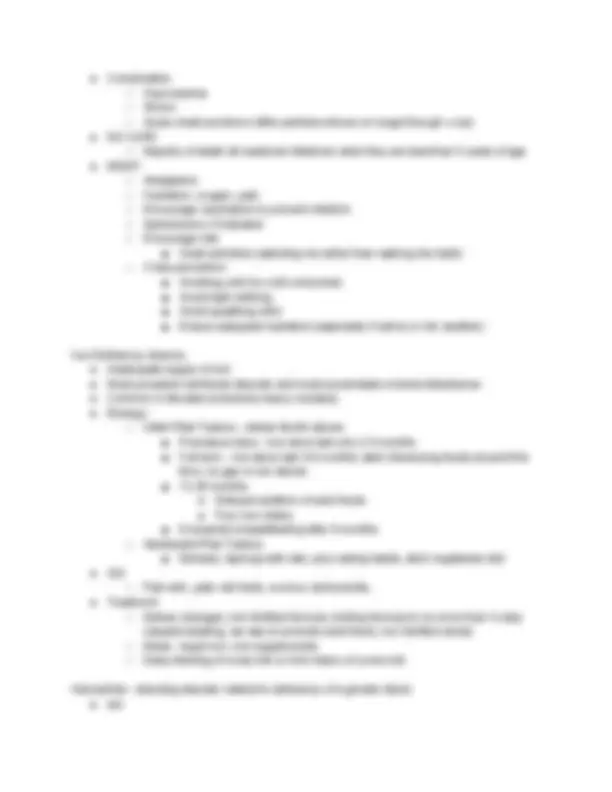
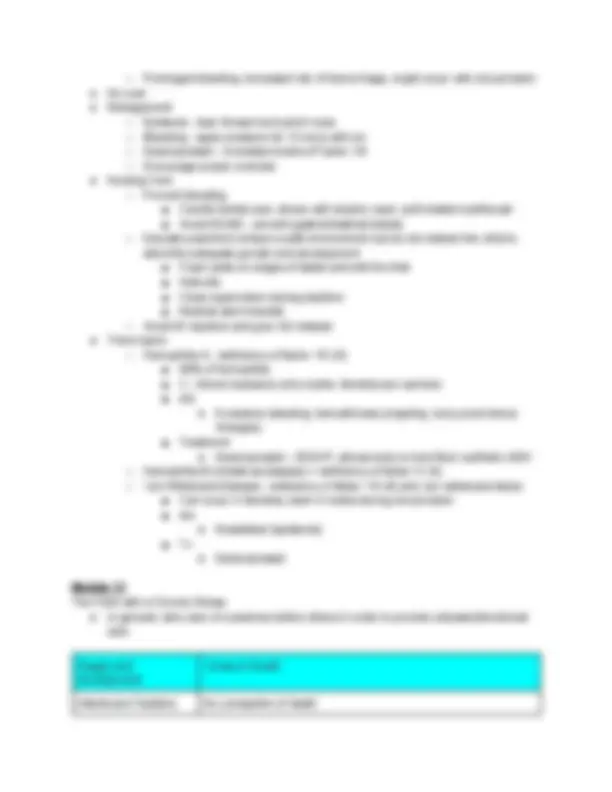
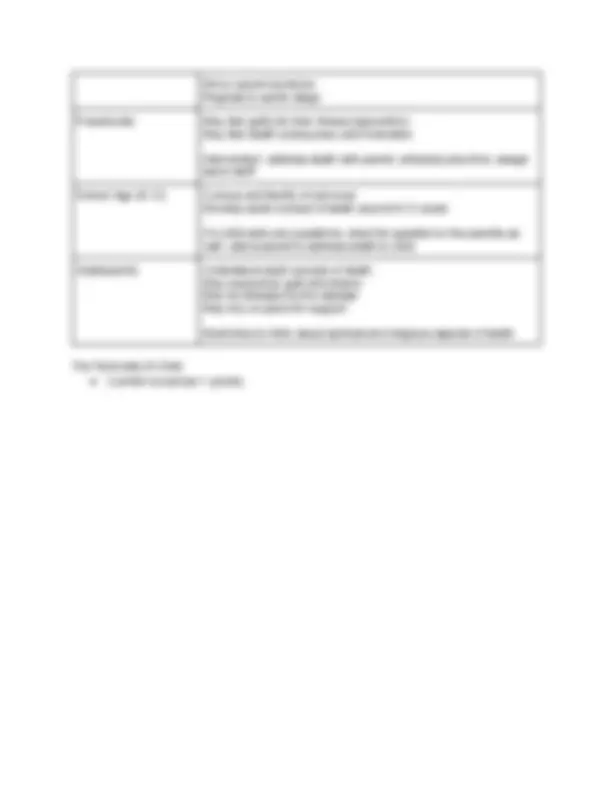


Study with the several resources on Docsity

Earn points by helping other students or get them with a premium plan


Prepare for your exams
Study with the several resources on Docsity

Earn points to download
Earn points by helping other students or get them with a premium plan
Community
Ask the community for help and clear up your study doubts
Discover the best universities in your country according to Docsity users
Free resources
Download our free guides on studying techniques, anxiety management strategies, and thesis advice from Docsity tutors
Final exam study guide for NRSG 3405
Typology: Study notes
1 / 31

This page cannot be seen from the preview
Don't miss anything!
























Module 1 Major Causes of Death/Illness/Injury During Childhood - accidental injuries ● Firearms and firearm related accidents ● MVA ● Drug overdose/poisoning & malignant neoplasm Infant Mortality ● Congenital Abnormalities ● Unintentional injury ● SIDS Child Abuse ● Highest risk of child abuse - Birth - 1 year ○ Due to caregiver fatigue ● Risk factors ○ Low socioeconomic status, less education, high stress ● Required by law to report any suspected child abuse Care of the Hospitalized Child ● Room pairings ○ Roommate must not be contracted with infectious disease ○ Same sex, similar disease processes ● Communication ○ Allow the child to feel comfortable with the nurse ○ Communicate through the use of objects ○ Allow the child to express fears and concerns ○ Speak clearly and in a quiet, unhurried voice ○ Offer choices when possible ○ Be honest with the child ○ Set limits with the child as appropriate ● Hospitalization Stressors ○ Separation anxiety ○ Fear of pain and injury ○ Loss of control ● Nursing Approach to Separation Anxiety ○ Rooming in ○ Reassure child that they will go home ○ Build trust with the child. Keep promises and don’t make empty promises Separation anxiety (3 stages) ● Protest ○ Cries, screams, searches for parents, tantrum ● Despair ○ Inactive, depressed/sad, withdrawn, uncommunicative, reclusive ● Detachment
○ Doesn’t give a shit ○ Happy, forms new relationships, does not care that parent is not there because they are used to it (detached from situation) Separation Anxiety in Preschoolers - Uncooperative Separation Anxiety in School Age ● Anxiety from missing school, friends, and family Separation Anxiety in Adolescent ● Anxiety from missing their friends Family Centered Care ● Recognizes that family is the one constant in the patient’s life ● Promote inclusion of family members in the treatment plan and support the needs of families along with patient ○ Provided consistent caregivers ○ Allow and encourage rooming in ○ Maintain familiar rituals ○ Encourage items to be brought from home to provide familiar environment ○ Assess coping skills ○ Encourage age appropriate activities ○ Empower parents through T.I.E.S ■ Teaching ■ Involving ■ Educating ■ Supporting ○ Teach about diagnostic procedures and exams ○ Evaluate environmental stimuli ○ Minimize fears and intrusive procedures. No painful procedure should be done in patient’s room Module 2: Newborn Considerations ● Baseline Vitals ○ Temp: 97.6 - ○ Pulse: 110- ○ Resp: 30- ○ BP: 60-90/30- ● Nursing Newborn Care ○ Maintain airway ○ Promote thermoregulation ■ Low temperature can indicate ● Cold ● Low blood sugar
■ 6 sense ■ Egocentric ○ Preoperational - 2 to 7 years ■ Symbolic thinking ■ Magical thinking/imagination ■ Animism ○ Concrete Operational - 7 to11 years ■ math/science ○ Formal Operational > 11 years ■ Abstract thinking ■ Hypothetical thinking Developmental Milestones ● 1 mo - head lag, strong grasp reflex ● 2 mo - supports head, smile ● 3 mo - no more grasp reflex ● 4 mo - rolls back to side, hold and reach for toys ● 5 mo - roll front - back ● 6 mo - roll back to front, sit tripod, holds bottle, stranger anxiety, object permanence begins ● 7 mo - know their own name ● 8 mo - sit unsupported, separation anxiety, object permanence developed ● 9 mo - pincer grasp, pull to stand, pleasing (understand no) ● 10 - 12 mo → one word meaning, walk supported ● 12 mo - turn multiple pages, two block structure and fails ● 15 mo - walk independently ● 18 mo - run clumsily, turn 2-3 pages, climbs stairs ● 24 mo - kick a ball, turn one page, turns door knob, parallel play begins ● 3 yr - tricycle, dresses themselves ● 4 yr - uses scissors, associative play begins Newborn Screening Protocol ● No national protocol, newborn screening is based on state ● Mandated testing is for PKU and congenital hypothyroidism ● May also screen for sickle cell and galactosemia ● Test is performed after 24 hours of birth ● Hearing Test ○ Before d/c from newborn nursery, if they can’t pass the hearing test the first time, try again 2-6 weeks later for amniotic fluid to get out of ear canal Jaundice/Hyperbilirubinemia ● Bilirubin is released from the destruction of RBC ● Two Types: ○ Conjugated bilirubin - excreted by intestine or kidneys (soluble)
○ Unconjugated Bilirubin - needs to be metabolized by liver into conjugated bilirubin (insoluble) ● Adverse Effects ○ The buildup of bilirubin in the blood can cause yellowing of the skin ○ Once the skin is full, bilirubin accumulates in the eye and brain causing yellowing of the sclera and kernicterus ● Physiologic Jaundice ○ Normal process that occurs in the first week of life (fetal destruction of RBC) ○ May have a deficiency of an enzyme that metabolize bilirubin ○ Delayed passage of meconium ● Pathologic Jaundice ○ ABO incompatibility ■ Child A, B, or AB and mom is O ○ Bruising or cephalohematoma ○ Sepsis ○ Other factors affecting the breakdown of bilirubin ○ Bilirubin > 12.9 = pathologic jaundice ■ > 20 = kernicterus → brain damage and cerebral palsy ● Breast Milk Jaundice ○ Not common ○ Substance in breast milk may interfere with bilirubin conjugation and/or cause increased reabsorption of bilirubin ● Treatment ○ Small frequent feeds ■ Stay hydrated → more poop → less bilirubin ○ Indirect exposure to sunlight ○ Skin - skin ○ UV phototherapy (bilirubin > 12) ■ Skin exposed to light, diapers on only, eyes covered ■ Isolette to prevent heat loss ○ If bilirubin levels continues to climb despite phototherapy → IVIG ■ Decreases the rate of hemolysis ○ Teach parents s/s of jaundice and interventions ○ Monitor bilirubin levels q8-12h ● Lifecycle of Newborn Blood Cells ○ 70-60 days ○ Adults 120 days ○ This leads to a high rate of RBC destruction and leads to more bilirubin ○ A mature liver would conjugate this and let it be excreted but newborns have immature liver ○ It takes 2 weeks for the liver to start conjugating bilirubin, until then the body gets rid of bilirubin through stool. As levels rise, bilirubin gets deposited into the skin and eyes
● 12-18 mo: MAD HPV ○ MMR, Hep A, Dtap, Hib, PCV, Varicella ● 4-6 year: Dtap, iPv, MMR, Varicella ● 11-12 year: Meningococcal, HPV, Dtap ● 16-18 year: Meningococcal Measles ● Highly contagious and most deadly of all childhood rash/fever illness ● Transmitted through air we breathe, coughing, and sneezing ● Infections from 4 days before the rash until 4 days after onset of rash ● S/S ○ Koplik’s spots - white spots inside the mouth - TELL TALE SIGN ○ Fever, malaise ○ 3 C’s - coryza, coughing, conjunctivitis ○ Rash appears red, maculopapular starting on face and spreading downward to feets ● Intervention ○ Use airborne droplet and contact precautions if hospitalized ○ Vitamin A supplements reduce the risk of death ○ Promote bed rest ● Vaccination ○ Live vax ○ Cannot be given until the child is 1 years old ○ 2 doses ■ 2nd dose must be completed before school Chickenpox ● Varicella zoster virus ● Spread by coughing and sneezing (highly contagious), by direct contact and aerosolization of virus from skin lesions ● Contagious until skin lesions have scabbed over ● S/S ○ Slight fever, malaise ○ Macular rash that appears on turn and scalp and moves to face and extremities ○ Lesions become pustules → dry → scabs ● Intervention ○ Varicella zoster immunoglobulin may be used for immunocompromised kids with no history of immunity ○ Acyclovir may be used to reduce symptoms ○ At home, isolate child until vesicles have dried and crusted over ● Vaccine ○ Live vax ○ Cannot be given until the child is 1 years old ○ 2 doses
■ 2nd dose must be completed before school Module 4 Otitis Media ● Inflammatory disorder usually caused by an infection of the middle ear occurring as a result of a blocked eustachian tube, which prevents normal drainage; can be acute or chronic ● Common complication of an acute respiratory infection (usually RSV or flu) ● Infants and children are more prone to otitis media due to shorter, wider, and straighter, eustachian tubes ● Risk Factors ○ Day care ○ Formula feeding ○ Prop feeding and allergies ● Prevention ○ Feed infants in an upright position, to prevent reflux ○ Maintain immunization (vax) ○ Encourage breastfeeding for first 6 months of life ○ Avoid exposure to smoke and tobacco ● S/S ○ Acute onset ear pain ○ Pulling on or rubbing ear ○ Purulent ear drainage ○ Red, opaque, building, immobile tympanic membrane ○ Signs of hearing loss (chronic) ● Intervention ○ Encourage fluid intake ○ Instruct child to avoid chewing as much as possible to decrease pain ○ Otitis drops Tonsillitis ● Inflammation of the tonsils caused by bacterial (GABHS) or virus ● S/S ○ Fever, bad breath, difficulty swallowing, mouth breathing, ○ Enlarged, bright red tonsils covered with white exudate. ● Treatment ○ Amoxicillin ○ Tonsillectomy ■ Assess for bleeding (frequent swallowing) ■ Discourage coughing, clearing, the throat, or blowing nose ■ Avoid red, purple, or brown liquids as this may mask blood ■ Ice pops ■ Avoid milk as this may cause throat secretions
○ Wheezing on expiration; inspiration if severe ○ Diaphoresis, fatigue ○ Dyspnea ■ Use of accessory muscles ○ Tachypnea ○ Restlessness, agitation ● Obstructive Process in Asthma ○ Bronchospasms ○ Increased mucus ○ Edema ● Treatment ○ Oxygenation ○ Prevention is key ■ Identify triggers and allergens ■ Treat acute respiratory illness ○ PEFR ○ Medications ■ Rescue meds ■ Daily meds ■ Delivery methods (spacer with corticosteroids MDI) ■ Magnesium can be used as a bronchodilator Module 5 Cardiac Development and Function Adult heart flow output is influenced by heart rate and stroke volume Neonates cannot change in stroke volume, leading to tachycardia They do not have strong heart muscles, so they compensate with tachycardia Patent Ductus Arteriosus
● Ductus arteriosus fails to close shunting blood from the aorta into the pulmonary artery during the first week of life ● S/S ○ Characteristic machine-like murmur ○ If small, patient may be asymptomatic ○ If medium to large, can lead to heart failure, particularly in premature infants ○ A large PDA not diagnosed in childhood → persistent pulmonary artery hypertension → fatal ○ Silent PDA → no treatment ● Treatment ○ Indomethacin (prostaglandin inhibitor) → help encourage closure ○ Closed by cardiac cath or surgery Congestive Heart Failure ● Right = blood is not able to return to heart; pools in body ○ Peripheral edema, ascites, hepatomegaly, JVD, weight gain, fatigue ● Left = blood is not able to disperse to body; pools in lungs ○ Pulmonary edema, tachypnea, tachycardia, crackles, wheeze, cyanosis, restlessness ● Management ○ Improve cardiac function (possibly with medications) ○ Decrease preload ○ Decrease cardiac demands ○ Improve tissue oxygenation ○ Decrease oxygen consumption ■ Keep at rest, treat fevers Kawasaki Disease ● Acute systemic vasculitis with increased risk of coronary artery aneurysm ● Common with children under 5 years old ● Cause is unknown ● Leading cause of heart disease in children; worried about cardiac functioning ● S/S ○ High fever; unresponsive to antipyretics ○ Strawberry tongue ○ Edema on hand and feet ○ Extreme inconsolable irritability ○ Desquamation of fingers and toes (nail bed) ○ Arthritis ● Nursing Management ○ Early diagnosis and treatment ○ High dose IV gamma globulin with salicylate therapy given over 10-12 hours ■ Reduces risk of coronary artery aneurysm ■ Started first 10 days of illness
Burns ● Extent of injury described as total body surface area ● Depth of injury ○ Superficial (first degree) ○ Partial thickness (second) ○ Full thickness (third) ○ Full thickness plus underlying tissue (fourth degree) ● Severity of Injury ○ Major - specialized burn center ○ Moderate - hospital with burn treatment ○ Minor - outpatient setting ● Complications ○ Immediate threat of airway compromise ■ Burning around lips and nose ○ Profound shock ○ Infection (local and systemic) - main complication ○ Inhalation injuries, aspiration, pulmonary edema, pulmonary embolus ■ Upper airway obstruction = ett ● Intervention: ○ Stop the burning process ○ Assess airways and vital signs ■ Airway maintenance is first priority ○ Cover the burn to prevent contamination ○ Fluid replacement is critical in the first 24 hours ● Indicators of Adequate Fluid Resuscitation ○ Urine output ○ Normalized vital signs ○ Cap refill Scabies ● Endemic infestation caused by the scabies mite ● Lesions are made from impregnated female mite, which burrows into the epidermis (never into living tissue) to deposit her eggs and feces ● Inflammatory process causes intense pruritus that leads to punctate excoriations secondary to the itching ● Lesion in Infants ○ Eczematous eruption, pruritic ○ Children younger than 2 usually have these on feet and ankles ● Lesion in children ○ Minute grayish brown, thread-like (mite burrows) pruritic. May have a black dot at the end of the burrow (the mite) ○ Children older than two primarily have them on hands and wrists ● Transmitted through prolonged close personal contact Treatment:
● Application of scabicide. Drug of choice for children older than 2 months is permethrin cream. Alternative meds are 10% crotamiton or oral ivermectin ● Because the length of time between infestation and physical symptoms is 30-60 days, all persons who were in close contact with the affected child must be treated Pediculosis ● Lice infestation on the scalp or body. Is a serious problem in schools and a social embarrassment ● Lice live only on humans and are transmitted by direct contact with person’s belongings (brush, combs or hats) ● They can jump ● Clean hair is not a deterrent ● Approximately 5 million cases a year ● Rarely occurs in African Americans ● Girls are twice as affected as boys ● All socioeconomic are affected ● May get so bad that it covers the whole scalp, pubic area and eye lashes Pathology: ● Lice pierce skin and suck out blood ● Severe itching is caused by bites and can predispose to secondary infection ● Head and pubic lice spend their life cycles on the skin of the human host ● Body lice can live in clothing ● Comes to the skin to feed ● Female louse lays eggs in the shaft of hair, tiny pearly whitish masses that are struck tight to the hair and the base of the hair shaft ● Lice pubis is spreading through sexual contact ● Lice may spread as long as lice and nits remain alive on the infested person or belongings ● Lice can live only 48 hours off the human host ● Nits shed into the environment are capable of hatching for 10 days, which is why you retreat in 10-14 days S/S: ● Nits (eggs) are visible and are attached firmly to the hair shafts ● Resemble dandruff and are difficult to remove ● Commonly found behind the ears and at the nape of the neck ● Are not killed by products and MUST be physically removed ● Adult lice are difficult to see and appear as small gray specks 102 mm long that crawl very fast and avoid light Treatment: ● 3-Tiered approach ● Killing the active lice with RIDX, Kwell (can be neurotoxic) ● Remove the nits ● Prevent spread or reoccurrence by managing the environment
■ 10-20: 40 + 2ml/kg for every kg over 10 ■ 20+: 60 + 1ml/kg for every kg over 20 ○ Daily ■ For the first 10: 100 ml/kg ■ 10-20: 1000 + 50 ml/kg for every kg over 10 ■ 20+: 1500 + 20 ml/kg for every kg over 20 Hypertrophic Pyloric Stenosis ● Narrowing of the pyloric sphincter (junction of the stomach and duodenum) due to thickening of the pyloric muscle ● Upper GI disease ● s/s ○ starving infant, poor weight gain, dehydration, distended upper abdomen, palpable olive shaped abdominal mass (RUQ) ○ Nonbilious, progressive, projectile vomiting ● Child is happy when fed, but they cry after vomiting because they are hungry ● Management ○ NPO - may go to procedure Diabetes Type 1 and 2 ● Chronic disorder of metabolism characterized by hyperglycemia and insulin resistance ● Most common endocrine dysfunction of childhood ● Peak incidence 10-15 years old ● Type 1: body doesn't produce insulin ○ Males affected more than females ● Type 2: body is resistance to insulin ○ Oral meds, dietary changes ● Mgmt: ○ No oral agents, insulin management, teach school age and older children how to administer self insulin, ○ glucose < 126 mg/dL, ○ educate s/s of hypo/hyperglycemia, ○ food given with insulin to prevent hypoglycemia, ○ Promote exercise and increase calories ○ Sick days - encourage lots of fluids, and do not restrict activity, monitor glucose q3h ● s/s ○ Polyuria, polydipsia, polyphagia, weight loss ● HbA1c - measure glucose over previous 2-3 months ● DKA - complication of uncontrolled diabetes; commonly seen with t1dm ○ often seen when child is first diagnosed with diabetes ○ Ketonuria, fruity breath, changes in LOC, kussmaul respirations ○ Management ■ Fluid first, then insulin
Anaphylaxis ● A hypersensitivity reaction to an allergen ● IgE stimulates the release of histamine from mast cells ● Histamine causes vasodilation, increases capillary permeability, allowing fluid to leak into the interstitial space ● Food allergies is the most common type of anaphylaxis outside of the hospital ● Management ○ Treat immediately with epi pen and pt should always carry one with them and have a med alert bracelet or card ○ Skin testing for allergies and triggers ● Nursing Priorities ○ Early recognition of symptoms, airway patency, adequate circulation restored and maintained, further exposure to allergic agent prevent Shock ● Hypovolemia: extensive fluid volume loss ○ Hemorrhage, burns ● Distributive: sepsis, anaphylaxis, anesthesia ● Cardiogenic: primary pump failure, dysrhythmia ● Management ○ Fluid administration 20 mL/kg normal saline bolus, (hypovolemic shock) ■ Be careful septic patients and those with cardiogenic shock (administer fluids slowly) ■ Need to asses and watch for fluid volume overload ● Ventilatory support ● Cardiovascular support ● General support Module 8 Normal and Abnormal GU Findings in Newborns ● Phimosis - foreskin that does not retract ● Balanitis - infection of the phimosis ● Hydrocele - fluid in the testes ● Cryptorchidism - undescended testes ○ Normal if they are less than 1 year old ○ Ochiopexy - surgical procedure for older children ● Hypospadia - hole on bottom of penis (ventral) ● Epispadia - hole on top of penis (dorsal) ● Chordee - ventral curvature of penis (dick curves down) ● Vesicourethral - urine flows back from bladder to kidney ○ Watch out for UTI, pyelonephritis Urinary Tract Infections
● Syphilis ○ 3 phases ○ Penicillin G ● Curable infections ○ Syphilis ○ Gonorrhea ○ Chlamydia ○ Trichomoniasis ● Incurable Infections ○ Hep B ○ HSV ○ HIV ○ HPV Assessing Sexual History From an Adolescent ● Most important thing is to build a trusting relationship ○ Longer you know them the better ○ Being calm and professional when speaking with them ● The 5 P ○ Partners ○ Past STD history ○ Pregnancy ○ Practices ○ Protection ● Make sure to assess if the adolescent is in a safe relationship and that they are not being abused, coerced or taken advantage of ● Don’t assume all sexual relationship are heterosexual Nursing Care of Child on Dialysis ● Scary experience for children ● Provide reassurance ● Help develop strategies to cope with restricted activities ● Adolescents suffer from lack of control ○ Allow maximum independence in course of treatment Module 9 The Child with a Fracture ● Types of fractures – familiarize with the different types ○ Simple – no break in skin ○ Compound – break in skin. ■ High risk of infection ○ Oblique – suspect child abuse ○ Complicated fracture – causes damage to other organs. ○ Comminuted – small fragment of bones lie in tissues
● More worried about toddler fractures in comparison to adolescent as bones are not fully developed. ○ May lead to structural dysfunction/deformity ● X-ray = gold standard diagnosis ● MRI – tendon, ligaments Fractures and Fracture Management ● Break or disruption in a bone’s continuity ● Occurs when excessive or traumatic force exceeds the strength of the bone Initial Management of a Fracture ● Immobilize the fracture site ● Apply ice ● Loosen, remove restrictive clothing ● Elevate extremity if possible ● If it an open (compound) fracture, stop any bleeding and cover the site to prevent infection ● Keep patient NPO, in case surgery is needed ● Assess for neurovascular status and whether is a perfusion emergency Intervention ● Reduction ○ Restoring the bone to proper alignment ○ Closed: accomplished by manual alignment of fragments, followed by immobilization ○ Open: surgical insertion of internal fixation devices, such as rods, wires, or pins, that help maintain alignment while healing occurs